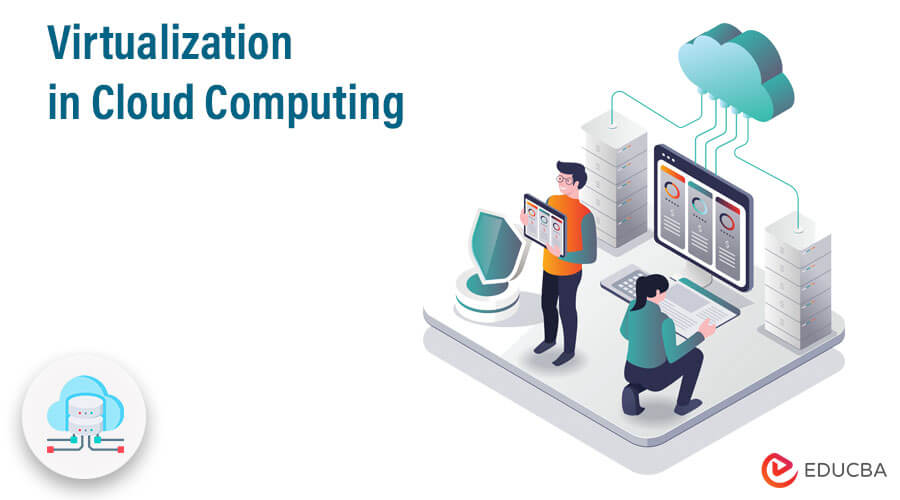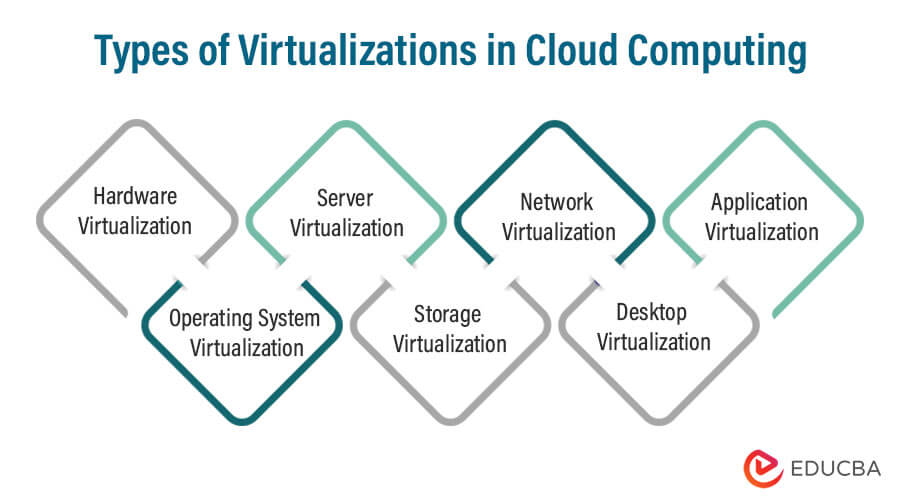Introduction to Virtualization in Cloud Computing
Virtualization in cloud computing enables the creation of virtual resources such as servers, storage, and networks independent of the underlying hardware.
The global virtualization software market is expected to reach $386.8 Billion by 2030, with a CAGR growth of 25.4%. The U.S. market alone has a valuation of $22.6 Billion.
Virtualization in cloud computing has many utilities and applications, such as server consolidation, improved disaster recovery, flexibility in scaling resources, and the ability to test and deploy new software applications quickly and efficiently.
Table of Content
- Introduction to Virtualization in Cloud Computing
- Working of Virtualization in Cloud Computing
- Types of Virtualizations in Cloud Computing
- Advantages and Disadvantages of Virtualization
Key Highlights
- Virtualization in cloud computing involves creating virtual instances of resources such as servers, storage, and networks.
- Features and characteristics of virtualization in cloud computing include hardware abstraction, resource pooling, hypervisors, containerization, network virtualization, storage virtualization, and desktop virtualization.
- The working of virtualization in cloud computing involves managing virtual instances of resources with software, such as hypervisors and containers.
- The advantages of virtualization in cloud computing include more efficient use of resources, improved flexibility, scalability, and management simplification.
- Disadvantages of virtualization in cloud computing include overhead, complexity, security risks, licensing, single points of failure, and vendor lock-in.
Working of Virtualization in Cloud Computing
Virtualization in cloud computing involves creating virtual instances of resources such as servers, storage, and networks. These virtual instances are then managed by software, which allows for more efficient and flexible use of resources.
1. Hardware abstraction:
- Virtualization abstracts the physical hardware resources of a server, storage device, or network into virtual instances that can be managed and allocated as needed.
2. Resource pooling:
- Virtualization allows for pooling resources, such as CPU, memory, and storage, across multiple physical devices.
- This enables more efficient use of resources and reduces wastage.
3. Hypervisor:
- A hypervisor, also known as a Virtual Machine Monitor (VMM), is software that creates and manages virtual machines (VMs) on a physical server.
- The two types of hypervisors are Type 1 hypervisors (bare-metal), which run directly on the server’s hardware, and Type 2 hypervisors (hosted), which run on top of the host operating system.
4. Containerization:
- A containerization is a lightweight form of virtualization that allows applications to run in isolated environments called containers.
- Containers share the operating system kernel of the host system, which reduces the overhead of virtualization and improves performance.
Types of Virtualizations in Cloud Computing
The types of virtualization in cloud computing include server virtualization, storage virtualization, network virtualization, desktop virtualization, application virtualization, and operating system virtualization.
1. Hardware Virtualization
- The virtual machine manager, i.e., VMM, is located and installed on the hardware system in hardware virtualization.
- The VMM installs as software in the hardware system, and hardware virtualization is enabled.
- The primary use of the hypervisor here is to monitor and control the memory, processor, and other hardware resources.
2. Operating System Virtualization
- In operating system virtualization, the VMM (Virtual Machine Manager) or the virtual machine software gets installed in a host’s operating system (OS) rather than hardware.
- Operating system virtualization allows multiple instances of an operating system to run on a single physical server.
- The primary use of operating system virtualization is for testing the applications on different operating systems, i.e., over a diverse platform of OS.
3. Server Virtualization
- Server virtualization is the most common type of virtualization in the cloud.
- It allows multiple virtual servers (VMs) to run on a single physical server.
- It can divide into many servers based on resource usage with the help of load balancing.
- Each virtual machine (VM) operates independently with its own operating systems, apps, and services. They are isolated from each other, demonstrating the efficiency of virtualization in cloud computing.
4. Storage Virtualization
- Storage virtualization is the abstraction of physical storage resources into logical storage devices.
- It allows multiple physical storage devices to be managed as a single logical unit, simplifying management and improving resource utilization.
- The primary usage of storage virtualization is to provide a backup and recovery process.
5. Network virtualization
- Network virtualization creates virtual networks that are logically isolated from each other.
- It allows multiple virtual networks to run on a single physical network, which improves network efficiency and security.
6. Desktop virtualization
- Desktop virtualization allows multiple virtual desktops to run on a single physical machine
- It enables users to access their desktop environments from any device, which improves productivity and flexibility.
7. Application virtualization
- Application virtualization separates the application layer from the underlying operating system.
- It allows applications to be run on different operating systems or platforms.
Advantages and Disadvantages of Virtualization in Cloud Computing
|
Advantages |
Disadvantages |
| Security: Protection from unauthorized access and cyber-attacks. |
Overhead: Additional resource requirements that may impact performance. |
| More Economical: Cost-saving and environmentally friendly. | Complexity: Adds complexity to IT infrastructure management, troubleshooting, and security. |
| Enabling Agile: Supports flexible and efficient operations. | Licensing: Some software vendors may require additional licensing fees for virtualized environments. |
| Efficient and Flexible Data Transfer: Easy to locate, transfer, and retrieve data. | Single Point of Failure: A physical server failure can impact the availability of critical applications. |
| No Risk of System Failure: Clustering ensures operational continuity. | Security: New security risks, such as VM escape attacks, require additional security measures. |
Final Thoughts
Cloud computing virtualization is now a crucial part of contemporary IT architecture. Virtualization provides more effective resource use, higher flexibility, and increased scalability by generating virtual instances of resources, including servers, storage, and networks. Virtualization has grown even more important since the introduction of cloud computing. It makes it possible to build virtualized environments in the cloud, enabling businesses to operate their applications and services on shared infrastructure.
Frequently Asked Questions (FAQs)
1. What is virtualization in cloud computing?
Answer: Virtualization is the technology that enables the creation of a virtual version of resources such as servers, storage, and networks, allowing multiple operating systems to run on a single physical server.
2. What are the three types of virtualizations?
Answer: The three types of virtualization are:
- Server virtualization
- Network virtualization
- Storage virtualization
3. What are the advantages of virtualization?
Answer: The advantages of virtualization are:
- Increased utilization of physical resources
- Reduced hardware and maintenance costs
- Improved scalability and flexibility
- Faster provisioning and deployment of resources
- Enhanced disaster recovery and backup capabilities.
4. What is an example of virtualization?
Answer: One example of virtualization is running multiple virtual machines (VMs) on a single physical server, each with its operating system and applications, allowing for efficient utilization of resources.
Recommended Articles
We hope that this EDUCBA information on “Virtualization in Cloud Computing” was beneficial to you. You can view EDUCBA’s recommended articles for more information.





